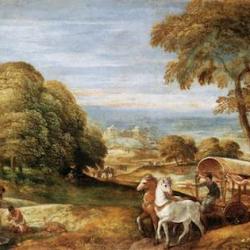In an essay in the 1978 collection, Perspectives on Luke-Acts, Donald Miesner explains the chiastic structure of Paul’s missionary journey:
A. Jerusalem to Antioch, Cyprus, Asia Minor, 12:25-13:14a
B. Paul’s initial address to Jews at Antioch, 13:14b-52
C. Paul is persecuted at Iconium, gives speech at Lystra, 14:1-28
D. Council at Jerusalem, 15:1-29
E. Paul to Antioch, 15:30-16:19
F. Paul and Silas charged and imprisoned at Philippi, 16:20-40
G. Paul in synagogue at Thessalonica, 17:1-15
H. The sermon at the Areopagus, 17:16-34
G’. Paul argues in synagogue at Corinth, 18:1-7
F’. Paul and Silas charged with breaking Jewish law, 18:8-18a
E’. Paul to Syria, 18:18b-19:20
D’. Paul plans travel to Jerusalem and Rome 19:21-41
C’. Paul teaches late a night in Toras, 20:1-7
B’. Paul’s farewell address to elders of Ephesus, 20:18-38
A’. From Asia past Cyrus to Jerusalem, 21:1-16
Miesner discusses the parallel sections in some detail, pointing out how lacunae in the narrative are filled out by the corresponding sections of the chiasm. Of G/G’, for instance, he notes that the accusation in Thessalonica is that Paul and his companions “turn the world upside down,” which corresponds to the reference to the decree of Claudius expelling Jews from Rome in G’: “Apparently, Claudius viewed the group to which Aquila and Priscilla belonged as insurgents much in the same way that the Thessalonians saw Paul and Silas as a threat to the throne” (212). Stress is placed on Paul’s isolation in Athens; G and G’ juxtapose apparently unnecessary travel notes. The effect, though is to emphasize that Paul goes to Athens on his own: “There he looms large as a man of epic proportion. He is the ‘conquering hero’ of the Greek-Christian world; he alone entered the lion’s den that is the Areopagus, and emerged, so to speak, ‘having eaten the lion.’ The conversion of the Areopagite vividly dramatized the power of the gospel” (212). In a footnote, he summarizes Ernst Haenchen’s discussion of the parallels between Paul and Socrates: “Both speak in the market place to every man; both were suspected of introducing new gods, and therefore were brought before the council.” Socrates drank hemlock; Paul survives and gains a following (212, fn 29).
One effect of the structure is to center attention on “the single model Pauline sermon to the gentiles,” the speech at Athens. This “speech symbolizes Paul’s penetration to the center of the Hellenistic cultural world” (213), and fits neatly with the other speeches in the sequence: “One of the speeches is in a Jewish synagogue, given to Paul’s countrymen; the second address is before the gentiles; and Paul’s pastoral farewell is delivered to the elders of a Christian community. The sermons are placed symmetrically within the missionary journey’s structure. The Antioch sermon is given near the start of Paul’s first of three missionary journeys; the Athens sermon is dramatically placed near the center of Paul’s second missionary journey; the Miletus address fittingly comes near the end of the third missionary journey. The Antioch sermon shows that the gospel was given first to the Jews, who rejected it; it was delivered through the Athens sermon to the gentile world; finally, it was entrusted to the church, comprised of both Jews and Greeks” (213). The sequence echoes the movement of the entire book of Acts, from Jerusalem to Rome, from Jew to Gentile.











